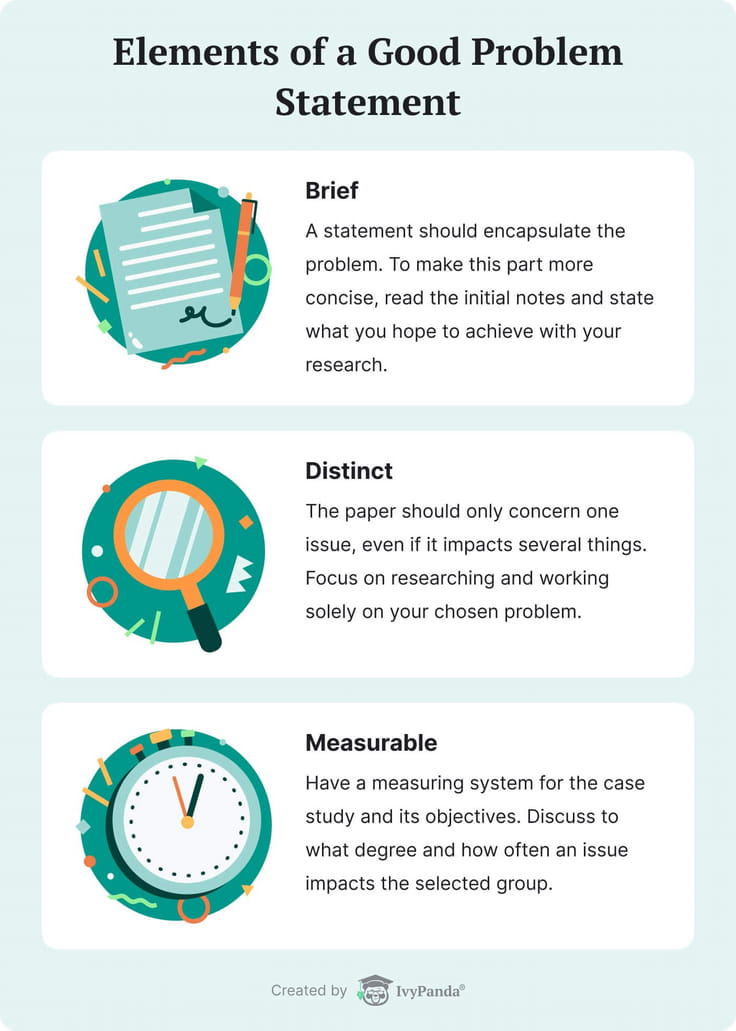Problem Statement Generator
📋 Problem Statement Objectives
Before setting on the journey of creating your problem statement, it is important to figure out all the basics. So, what is it, exactly? And how does a problem statement differ in business and research? Here, we have outlined the answers to these questions and more!
What Is a Problem Statement?
Creating a problem statement is an important step in solving and researching issues. You can find this notion explored in academia, as well as the field of business. For example, with the help of a problem statement, students can describe an issue they wish to explore and research. Meanwhile, in business, problem statements establish things that keep a company from achieving its goals.

Problem Statements in Business.
Everybody on the staff has to understand the consequences of leaving things as they are. In other words, a problem statement gives a clear case for a particular project. The different company departments can later use the document to approach issues from their angle. In many cases, they come up with more than one strategy.
This way, a business has a clear path toward achieving desired results. A well-written problem statement is at the core of planning any project. Businesses use it to analyze issues better and develop practical solutions. Problem statements keep everybody involved on track.
Problem Statements in Research.
This notion looks a little different for college papers and academic research. Here, a statement admits the existence of an issue. One should also provide supporting evidence. You should define significant terms and concepts, perhaps in a separate subsection. Additionally, discuss the background and the probable problem causes.
College students can use problem statements to find concerning issues and research them in a structured manner. This activity is often reserved for essay and thesis writing. It helps identify issues and provides ways of coming up with a solution. It also shows why additional data is required to realize a solution. Problem statements lie at the basis of research questions.
Why Generate a Problem Statement
Making researchable problem statements is an essential part of writing a thesis statement when working on an essay. This method allows you to plan ahead and structure your research. The problem statement template serves several purposes:
- They explain the problem in a detailed but concise manner. One glance at them gives people a thorough understanding of the issue.
- Problem statements make it clear what is expected from solving issues. They provide an approximate picture of what a desired outcome looks like.
- Lastly, they serve as a guideline for the entire project. You can use problem statements to stay on track and ensure that you can answer your research question.
🖊 Formulating a Problem Statement
A well-tailored statement must show the context and the purpose of your work or research. We've made a step-by-step guide on formulating a problem, so you don't miss anything. If you don’t know how to write a general problem statement, use this short instruction:
The Problem Statement Formula
No matter your research area, every problem statement should try to follow the same basic formula. There are four components that comprise it:
- The Problem. Identify what the issue is in one or two sentences. Readers should clearly understand what it's about.
- The Background. This section details the context of the issue. It also describes when the problem happens, how often, where, and who it affects.
- The Relevance. One should explain why the issue is pressing and why others should worry about it. Provide data that underlines the situation's urgency and the ramifications of not addressing it.
- The Objectives. Finally, you must briefly state hypothetical solutions to a problem and their benefits.
Furthermore, successful problem statements typically incorporate three elements. They should be brief, distinct, and measurable.

✅ Tips to Write a Good Problem Statement
We've also prepared effective and easy-to-understand advice about writing your problem statements. You can find these elements in every statement of the problem generator made by our tool.
-
Stay concise.
There's no need to make long and complicated problem statements. Keep them as brief and cohesive as possible. Only address the important facts and data related to the problem and possible solutions. If you need help cutting your statement down, consider using a summarizer. -
Keep things simple.
When working on the document, keep your readers in mind. The statement should be easy enough for anyone to comprehend. Avoid using technical language if you are writing for a general audience. -
Write in a formal tone.
Compose your problem statements in a formal tone without using slang or colloquialisms. They should be comprehensible and conventional to academic standards. Keep paraphrasing your statement until it sounds professional. -
Comb for errors.
Another important aspect of writing a statement is checking for potential mistakes. A great way to achieve that is by having it read aloud. The problem statement should have the right flow, well-formulated ideas, and be error-free. Proceed with your work only once you fix any formatting, grammatical, or spelling mistakes. -
Ensure that it answers the five questions.
Each problem statement must ask these queries: why, what, who, when, and where. Once you can answer them, it will make it easier for readers to understand issues and proposed solutions.
Defining and writing a precise problem statement is crucial to any project or research. We hope our advice and problem statement generator will help your work. If you have any more questions, check out the FAQ below!
❓ Problem Statements – FAQ
Updated:
🔗 References
- Problem Statement, Purpose Statement, and Research Question – Dissertation Center, National University
- Problem statement - Pernille Risør Elving, Aarhus University
- How to write the Statement of a Problem - Charlesworth Author Services
- How To Write a Problem Statement (With an Example) - Indeed Editorial Team, Indeed
- Organizing Academic Research Papers: The Research Problem/Question - Sacred Heart University